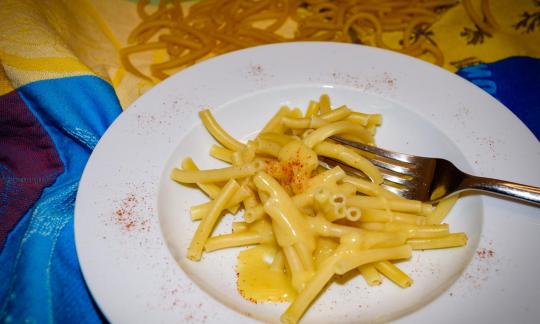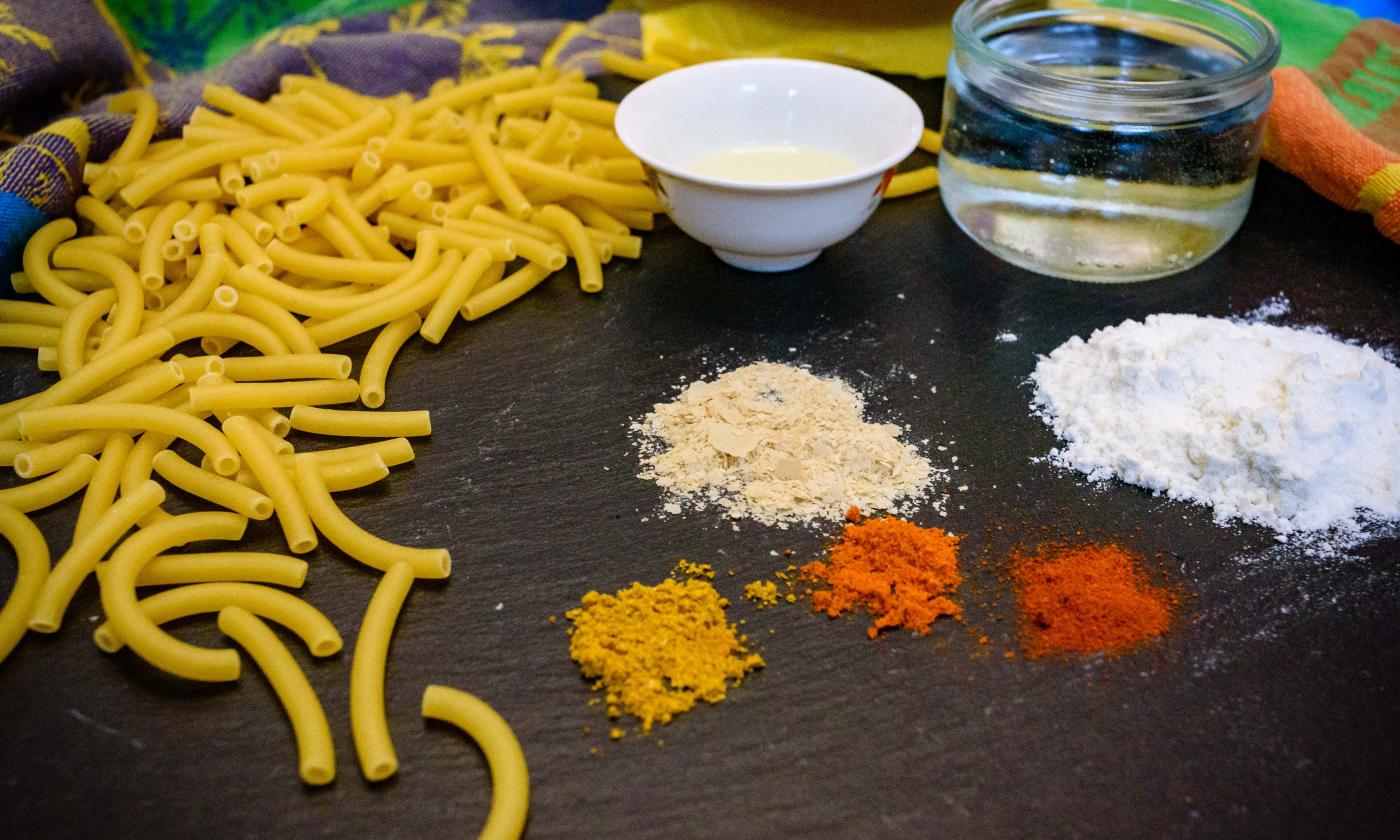Quick vegan "cheese sauce" without cashews
vegan
Ingredients (for servings, )
| 1 tbsp | Rapeseed oil, refined (organic?) (0.49 oz) |
| ¼ tsp | Curry powder (organic?, raw?) (0.02 oz) |
| ¼ tsp | Chili powder (raw?, organic?) (0.02 oz) |
| ¼ tsp | Paprika powder, sweet (raw?, organic?) (0.02 oz) |
| 1 tbsp | Wheat flour (raw?, organic?) (0.35 oz) |
| 100 ml | Drinking water, raw (organic?) (3.5 oz) |
| 1 tsp | Yeast flakes: noble yeast, nutritional yeast, yeast powder (raw?, organic?) (0.05 oz) |
Equipment
- whisk
- stove
- saucepan
Type of preparation
- sweat
- season to taste
Preparation
Preparation of the "cheese sauce"
Heat the rapeseed oil in a pan. Add the curry, paprika and chili powder and let it sauté slightly.We used hot curry powder and sweet paprika.
Add flour and stir (don't worry if it lumps, that's normal at this point). Add water and stir with a whisk until you have a creamy sauce (you may need to add more water). Season with salt and nutritional yeast to taste.
Since salt needs vary from person to person, we have not specified a specific amount. Use enough so that the sauce is flavorful but not too salty.
If you don't use the sauce straight away, it will thicken. If this happens, just add a little water and heat again while stirring.
|
Nutritional Information per person
Convert per 100g
|
2000 kcal | |
|---|---|---|
| Energy | 86 kcal | 4.3% |
| Fat/Lipids | 7.2 g | 10.3% |
| Saturated Fats | 0.57 g | 2.9% |
| Carbohydrates (inc.dietary fiber) | 4.3 g | 1.6% |
| Sugars | 0.14 g | 0.2% |
| Fiber | 0.60 g | 2.4% |
| Protein/Albumin | 1.0 g | 2.1% |
| Cooking Salt (Na:12.4 mg) | 31 mg | 1.3% |
| Essential micronutrients with the highest proportions | per person | 2000 kcal | |
|---|---|---|---|
| Vit | Thiamine (vitamin B1) | 0.28 mg | 25.0% |
| Fat | Alpha-Linolenic acid; ALA; 18:3 omega-3 | 0.50 g | 25.0% |
| Fat | Linoleic acid; LA; 18:2 omega-6 | 1.4 g | 14.0% |
| Min | Selenium, Se | 2.2 µg | 4.0% |
| Min | Manganese, Mn | 0.07 mg | 3.0% |
| Vit | Riboflavin (vitamin B2) | 0.04 mg | 3.0% |
| Prot | Tryptophan (Trp, W) | 0.01 g | 3.0% |
| Vit | Vitamin A, as RAE | 22 µg | 3.0% |
| Min | Iron, Fe | 0.22 mg | 2.0% |
| Sodium, Na | 12 mg | 2.0% | |
Detailed Nutritional Information per Person for this Recipe
The majority of the nutritional information comes from the USDA (US Department of Agriculture). This means that the information for natural products is often incomplete or only given within broader categories, whereas in most cases products made from these have more complete information displayed.
If we take flaxseed, for example, the important essential amino acid ALA (omega-3) is only included in an overarching category whereas for flaxseed oil ALA is listed specifically. In time, we will be able to change this, but it will require a lot of work. An “i” appears behind ingredients that have been adjusted and an explanation appears when you hover over this symbol.
For Erb Muesli, the original calculations resulted in 48 % of the daily requirement of ALA — but with the correction, we see that the muesli actually covers >100 % of the necessary recommendation for the omega-3 fatty acid ALA. Our goal is to eventually be able to compare the nutritional value of our recipes with those that are used in conventional western lifestyles.
| Essential fatty acids | per person | 2000 kcal |
|---|---|---|
| Alpha-Linolenic acid; ALA; 18:3 omega-3 | 0.50 g | 25.0% |
| Linoleic acid; LA; 18:2 omega-6 | 1.4 g | 14.0% |
| Essential amino acids | per person | 2000 kcal |
|---|---|---|
| Tryptophan (Trp, W) | 0.01 g | 3.0% |
| Threonine (Thr, T) | 0.02 g | 2.0% |
| Isoleucine (Ile, I) | 0.03 g | 2.0% |
| Leucine (Leu, L) | 0.05 g | 2.0% |
| Phenylalanine (Phe, F) | 0.03 g | 2.0% |
| Valine (Val, V) | 0.03 g | 2.0% |
| Lysine (Lys, K) | 0.02 g | 1.0% |
| Methionine (Met, M) | 0.01 g | 1.0% |
| Vitamins | per person | 2000 kcal |
|---|---|---|
| Thiamine (vitamin B1) | 0.28 mg | 25.0% |
| Riboflavin (vitamin B2) | 0.04 mg | 3.0% |
| Vitamin A, as RAE | 22 µg | 3.0% |
| Niacin (née vitamin B3) | 0.30 mg | 2.0% |
| Vitamin B6 (pyridoxine) | 0.03 mg | 2.0% |
| Vitamin E, as a-TEs | 0.21 mg | 2.0% |
| Folate, as the active form of folic acid (née vitamin B9 and | 3.8 µg | 2.0% |
| Pantothenic acid (vitamin B5) | 0.07 mg | 1.0% |
| Vitamin K | 0.62 µg | 1.0% |
| Vitamin B12 (Cobalamin) | 0.01 µg | 1.0% |
| Vitamin C (ascorbic acid) | 0.00 mg | < 0.1% |
| Essential macroelements (macronutrients) | per person | 2000 kcal |
|---|---|---|
| Sodium, Na | 12 mg | 2.0% |
| Calcium, Ca | 6.0 mg | 1.0% |
| Magnesium, Mg | 4.6 mg | 1.0% |
| Phosphorus, P | 7.8 mg | 1.0% |
| Potassium, K | 21 mg | 1.0% |
| Essential trace elements (micronutrients) | per person | 2000 kcal |
|---|---|---|
| Selenium, Se | 2.2 µg | 4.0% |
| Manganese, Mn | 0.07 mg | 3.0% |
| Iron, Fe | 0.22 mg | 2.0% |
| Copper, Cu | 0.02 mg | 2.0% |
| Zinc, Zn | 0.09 mg | 1.0% |
| Fluorine, F | 37 µg | 1.0% |
| Iod, I (Jod, J) | 0.01 µg | < 0.1% |
This quick vegan "cheese sauce" without cashews is not only quick and easy to prepare, but also extremely low in calories.
Nutrient profile: This vegan cheese sauce is very low in calories, with less than 90 kcal per 100 g. According to GDA guidelines, one portion of this sauce covers ¼ of the average daily requirement of vitamin B1 and the important omega-3 fatty acid. Vitamin B1, also known as thiamine, performs many tasks in energy metabolism and the nervous system. The sauce also contains a good ratio of omega-6 to omega-3 fatty acids, which at 3:1 clearly meets the recommended maximum ratio of 5:1.
Read more at: Vegans often eat unhealthily. Avoidable nutritional errors.
Rapeseed oil: Rapeseed oil has a high proportion of essential fatty acids, especially omega-3 fatty acids. Cold-pressed rapeseed oil is not suitable in this case, as cold-pressed oils can only be heated slightly, in the case of cold-pressed rapeseed oil up to a maximum of 120 °C, as otherwise harmful substances are created. But even refined rapeseed oil should only be heated to a maximum of 180 °C.
Yeast flakes: Normal yeast flakes, also So-called noble yeast, it consists of inactivated yeast (single-celled fungi) that is first dried and then processed into small flakes. Noble yeast is used in the kitchen for low-sodium seasoning and thickening of soups, sauces, salads and for sprinkling on savoury dishes. Noble yeast flakes have a mild nutty to cheesy taste and have a flavour-enhancing side effect. Since the B vitamins they contain are very heat-sensitive, it is important to avoid heating the yeast flakes if possible, so it is better to add them after cooking.
Reheating: You can also prepare the "cheese sauce" in advance. Since it solidifies when it cools, simply stir in a little more water when reheating.






